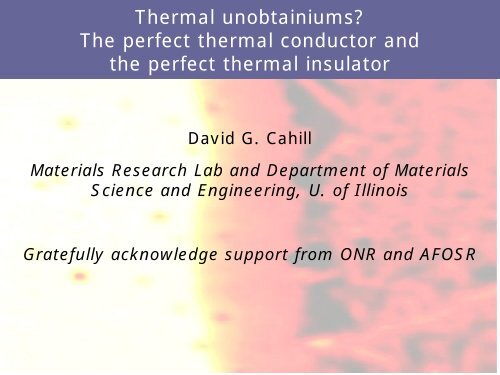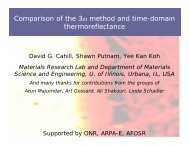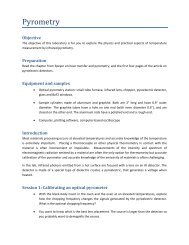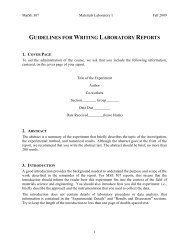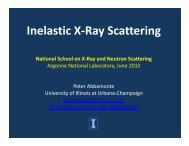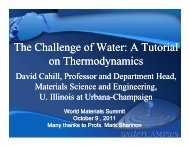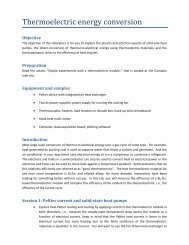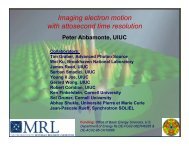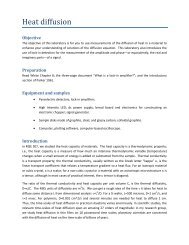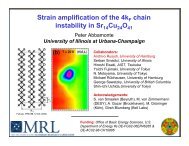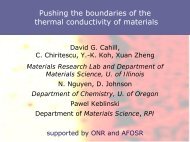The perfect thermal conductor and the perfect thermal insulator
The perfect thermal conductor and the perfect thermal insulator
The perfect thermal conductor and the perfect thermal insulator
Create successful ePaper yourself
Turn your PDF publications into a flip-book with our unique Google optimized e-Paper software.
<strong>The</strong>rmal unobtainiums?<strong>The</strong> <strong>perfect</strong> <strong><strong>the</strong>rmal</strong> <strong>conductor</strong> <strong>and</strong><strong>the</strong> <strong>perfect</strong> <strong><strong>the</strong>rmal</strong> <strong>insulator</strong>David G. CahillMaterials Research Lab <strong>and</strong> Department of MaterialsScience <strong>and</strong> Engineering, U. of IllinoisGratefully acknowledge support from ONR <strong>and</strong> AFOSR
Outline—toward <strong>perfect</strong> <strong><strong>the</strong>rmal</strong> <strong>conductor</strong>s• Conventional conduction of heat in solids byphonons <strong>and</strong> electrons– phonon scattering mechanisms in dielectriccrystals– metals• Examples of unconventional heat conduction– Poiseuille flow of heat– ambipolar heat conduction• Heat conduction in Bose condensates– electronic super<strong>conductor</strong>s– superfluid helium– Bose condensate of magnons
Outline—toward <strong>perfect</strong> <strong><strong>the</strong>rmal</strong> <strong>insulator</strong>s• Einstein <strong>and</strong> minimum <strong><strong>the</strong>rmal</strong> conductivity• Localization of lattice vibrations by disorder• Beating <strong>the</strong> minimum with anisotropicdisordered materials: disordered layeredcrystalsConclude with some thoughts on promising,high-risk, research directions
Gas kinetic equation is a good place to start• Anharmonicity (high Tlimit)τ− 1∝ ω2 T• Point defect scatteringτ− 1 4∝ω• Boundary scatteringτ − 1∝1/dCahill <strong>and</strong> Pohl, Ann. Rev. Phys. Chem. 39, 93 (1988)
Peak occurs at T ∼ Θ Debye /30 in typical crystals• Anharmonicitycontrols conductivitynear roomtemperature.– k is not a <strong>perfect</strong>quantum number• Not possible (?) toeliminateanharmonicities evenin a computer model.
<strong>The</strong>rmal resistance is created by Umklappscattering (U-process)• Illustration gives examples of:N-process T+L → LU-process T+T → L• Considerations of symmetry <strong>and</strong>dimensionality are subtle <strong>and</strong> complex, seeHerring Phys. Rev. (1954).Peierls, Ann. Phys. 3, 1055 (1929)
Isotopes contribute to <strong><strong>the</strong>rmal</strong> resistance• Isotopically pure diamond has highest <strong><strong>the</strong>rmal</strong>conductivity of any materialWei et al., PRL 70, 3764 (1993)
Carbon nanotubes• Evidence for <strong>the</strong> highest <strong><strong>the</strong>rmal</strong> conductivityany material (higher conductivity th<strong>and</strong>iamond)Yu et al. (2005)Maruyama (2007)
High Debye temperature also produceshigh conductivity in metals• Phonons disrupt <strong>the</strong>periodicity of <strong>the</strong>lattice– k is not a goodquantum number• Pure metals havehigh conductivity atlow temperaturesΛ=LσTMueller et al., APL 57, 240 (1990)
Unconventional heat conduction: Poiseuilleflow of phonons• Counter-intuitive:strong N-processesscreen <strong>the</strong> interactingphonon gas from <strong>the</strong>boundaries of <strong>the</strong>crystal.• RequireslUlNrrLimited to He crystals(?)Hogan, Guyer, <strong>and</strong> Fairbank, PR 185, 356 (1969)
Ambipolar diffusion contributes to heatconduction.• In an intrinsicsemi<strong>conductor</strong>, e-h pairsdiffuse from hot-to-cold,driven by <strong>the</strong>concentration gradient.• Each pair carriers <strong>the</strong>b<strong>and</strong>-bap energy (but nocharge).Glassbrenner <strong>and</strong> Slack, PR 134, A1058 (1964)
Super<strong>conductor</strong>s are an effective heat switch• Strong magnetic fieldsquenchessuperconductivity.• Normal electrons carryheat but Cooper pairsdo not.Schubert, RSI 55, 1486 (1984)
But unconventional metals show avariety of behaviorYBCO B-field dependenceMgB 2Schneider et al.,Physica C 363, 6 (2001)Peacor, Cohn, Uher, PRB 43, 8721 (1991)
Superfluid He near T c has a conductivitycomparable to Si at room temperature• Counter-flow of normal fluid <strong>and</strong> superfluid<strong>The</strong>rmometer spacing is 1.6 cm2.2 mW/cm 28.8 mW/cm 2Leiderer <strong>and</strong> Pobell, JLTP 3, 577 (1970).
Could a solid-state Bose condensate showthis superfluid behavior?• magnons (quantizedspin waves) arebosons.• Do magnons Bosecondense in anapplied field?Kudo et al., JMMM 272, 214 (2004)
Produce low conductivity withnanoscale boundary scattering
Nanoscale boundary scattering reduces<strong>the</strong> <strong><strong>the</strong>rmal</strong> conductivityCompilation of data for Sinanowires <strong>and</strong> thin films• Debye-Callaway-Morelli model• Length-scale thatreduces Λ by x2– Si: 300 nm– InGaAs: 200 nm– PbTe (predicted):15 nmKoh <strong>and</strong> Cahill, unpublished
Etched (rough) nanowires showanomalously low conductivity
Disorder creates localization in 1D1D crystalMass disorderHe <strong>and</strong> Maynard, PRL 57, 3171 (1986)
Einstein (1911)• coupled <strong>the</strong> Einsteinoscillators to 26neighbors• heat transport as ar<strong>and</strong>om walk of<strong><strong>the</strong>rmal</strong> energybetween atoms; timescale of ½ vibrationalperiod• did not realize waves(phonons) are <strong>the</strong>normal modes of acrystal
Works well for homogeneousdisordered materialsamorphousdisordered crystalCahill, Watson, <strong>and</strong> Pohl, PRB (1991)
Time domain <strong>the</strong>rmoreflectance since 2003• Improved optical design• Normalization by out-ofphasesignal eliminatesartifacts, increases dynamicrange <strong>and</strong> improvessensitivity• Exact analytical model forGaussian beams <strong>and</strong>arbitrary layered geometries• One-laser/two-colorapproach tolerates diffusescattering, see Kang et al.,RSI (2008)Clone built at Fraunhofer Institute forPhysical Measurement, Jan. 7-8 2008
Layered disordered crystals: WSe 2 by“modulated elemental reactants”• Deposit W <strong>and</strong> Selayers at roomtemperature on Sisubstrates• Anneal to removeexcess Se <strong>and</strong>improve crystallinity• Characterize by RBS,x-ray diffraction (labsources <strong>and</strong> AdvancedPhoton Source) <strong>and</strong>TEMD. Johnson <strong>and</strong> co-workers
Cross-sectional TEM of 60 nm thick WSe 2Kim, Zuo et al., JMR (2008)
<strong>The</strong>rmal conductivity of WSe 2• 60 nm film has <strong>the</strong> lowest<strong><strong>the</strong>rmal</strong> conductivity everobserved in a fully densesolid. Only twice <strong>the</strong> <strong><strong>the</strong>rmal</strong>conductivity of air.• A factor of 6 less than <strong>the</strong>calculated amorphous limitfor this material.Chiritescu et al., Science 315, 351 (2007)
Conclusions from <strong>the</strong>oretical work(Hu <strong>and</strong> Keblinski, unpublished)• Analysis of <strong>the</strong> participation ratio: phononlocalization is not significant.• Analysis of mode polarization: incoherent grainboundaries create diffusive but non-propagatingvibrational modes. (stacking faults are notsufficient)• Key to ultralow <strong><strong>the</strong>rmal</strong> conductivity is disorder incombination with anisotropy, i.e., an “anisotropicglass”.• Interface resistance between 2D crystallinesheets? Lowering of <strong>the</strong> effective density ofstates for modes diffusing perpendicular to <strong>the</strong>sheets?
Back to experiment: Can we lower <strong>the</strong>conductivity even fur<strong>the</strong>r?• Syn<strong>the</strong>size misfitlayered compounds byelemental reactantsmethod (Johnson <strong>and</strong>co-workers)– WSe 2 /PbTe– MoSe 2 /PbTe• Interface density doesnot matter. Conductivitydetermined bycomposition notinterface density.Chiritescu et al., JAP (2008)
Conclusions <strong>and</strong> research directions• Hard for me to see a promising path toward“ultrahigh” <strong><strong>the</strong>rmal</strong> conductivity (conductivityhigher than diamond at room temperature)• But we could think outside-<strong>the</strong>-box about…– design of molecular structure to provideultrahigh conductivity polymers– searching for superfluid-type heat conduction insolid-state Bose condensates• Ultralow conductivity (conductivity lower thanaccepted minimum) has been demonstrated.– extend <strong>and</strong> ehance this physics for <strong><strong>the</strong>rmal</strong>barriers <strong>and</strong> <strong>the</strong>rmoelectrics– need to underst<strong>and</strong> <strong>the</strong> physics of roughnanowires; localization in 1D?
Research directions• Passive <strong>and</strong> active control of heat conduction– <strong>The</strong>rmal regulator, <strong><strong>the</strong>rmal</strong> switch, <strong><strong>the</strong>rmal</strong>rectifier– Phase transformations are (to me) mostpromising route– Applications for passive temperature control;electrocaloric cooling; <strong><strong>the</strong>rmal</strong> protection
Extras slides start hereV. Narayanamurti <strong>and</strong> R. C. Dynes, PRL 28, 1461, (1972).


